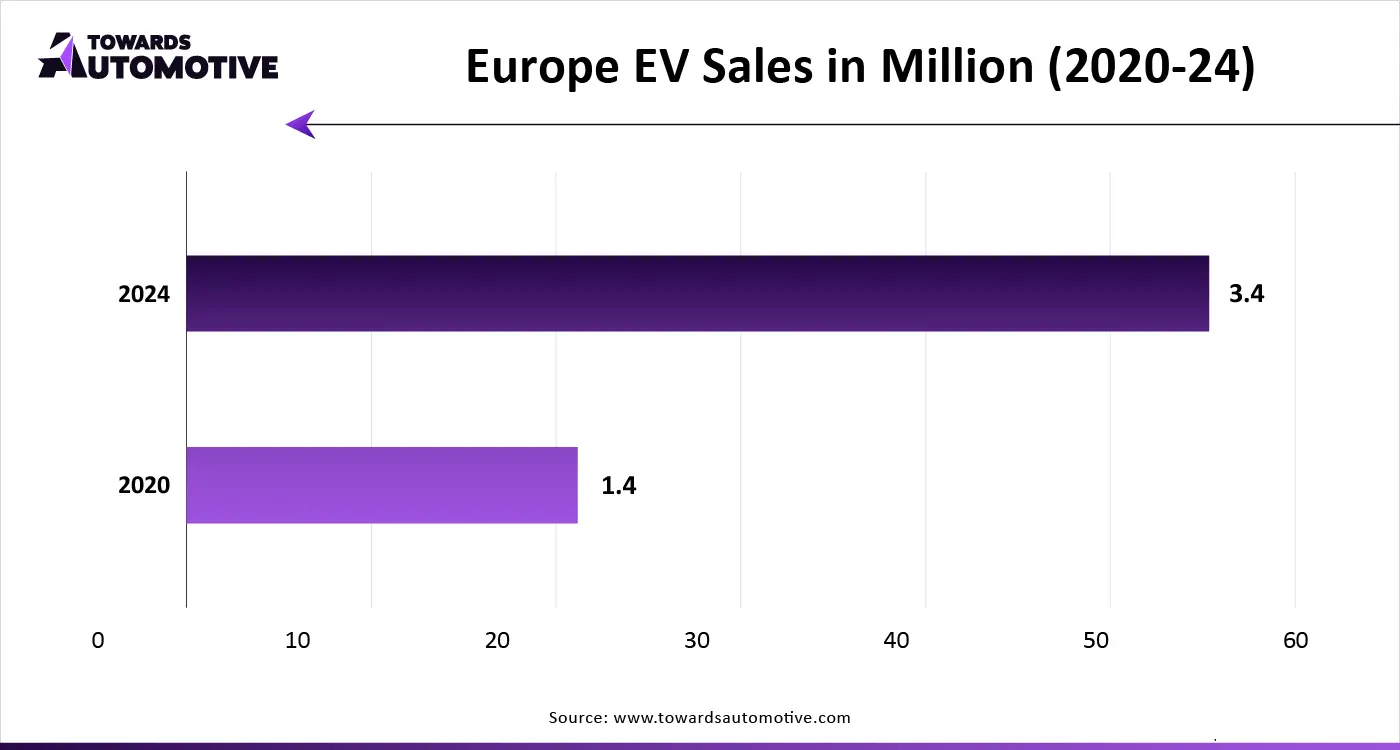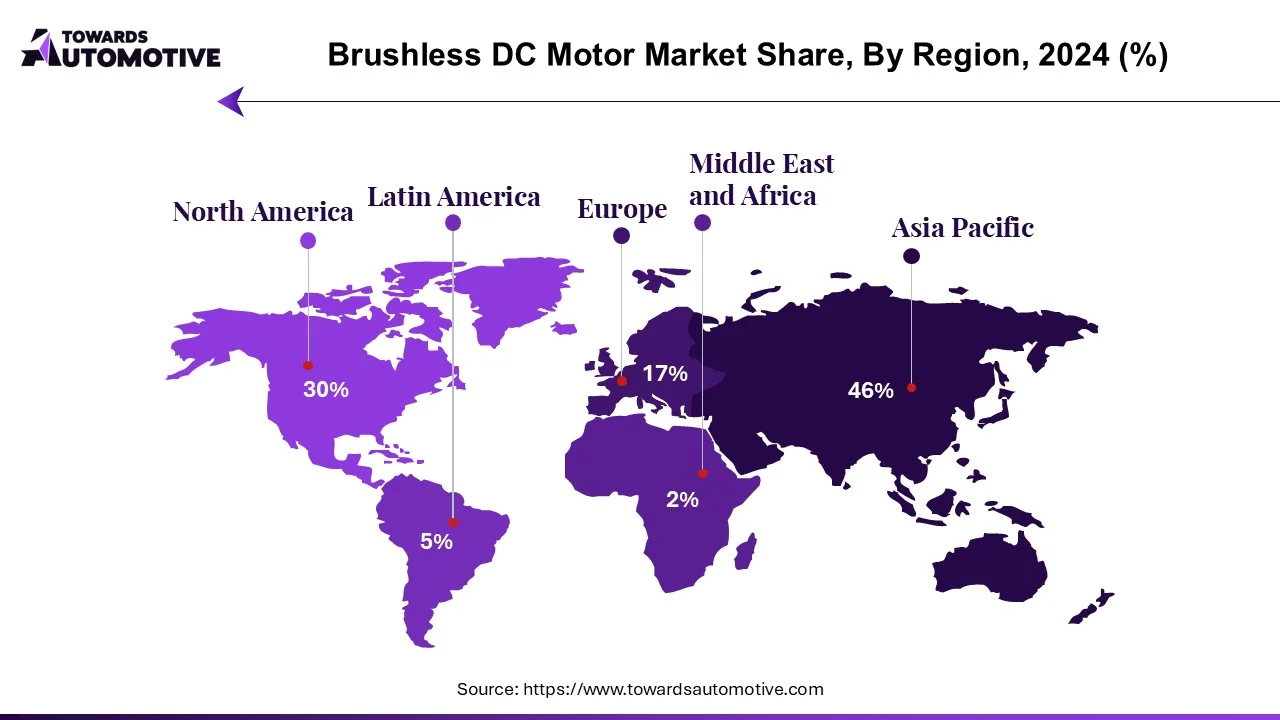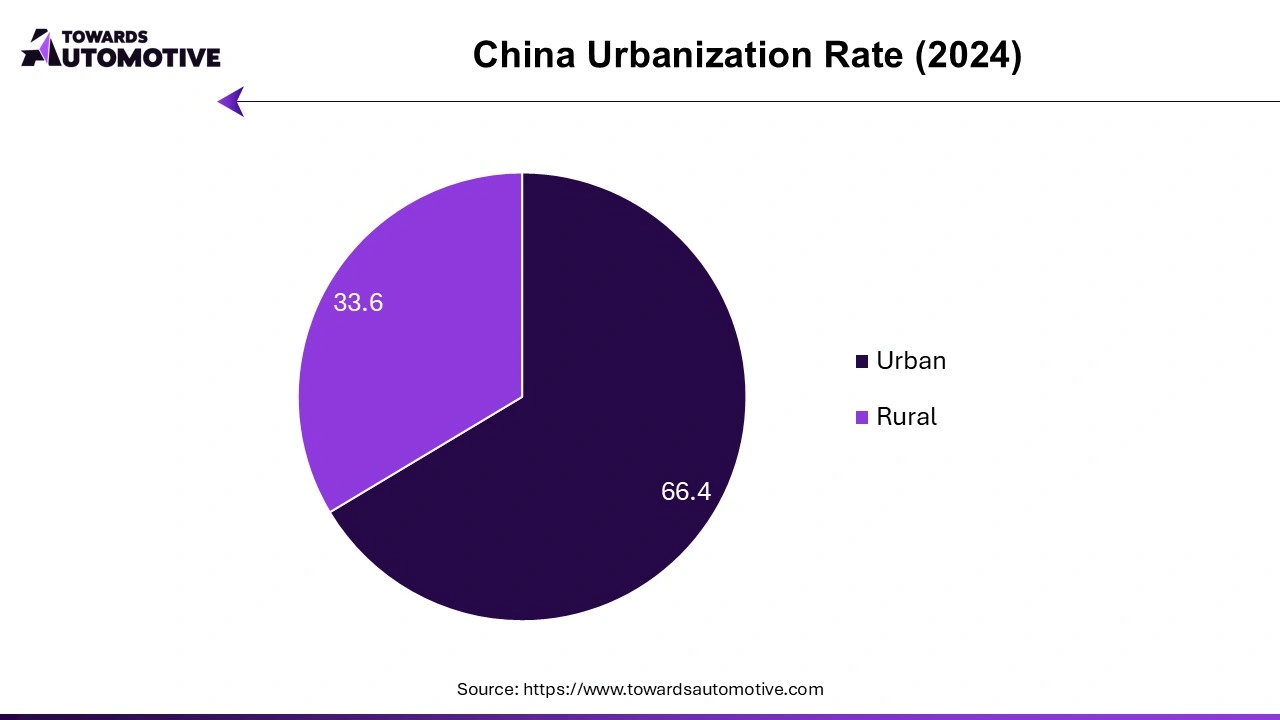July 2025
The brushless DC motor market is projected to reach USD 34.94 billion by 2034, expanding from USD13.79 billion in 2025, at an annual growth rate of 10.88% during the forecast period from 2025 to 2034.

The brushless DC motor market is experiencing significant growth driven by several key factors, including the rising demand for energy-efficient motors across various industries. Brushless DC (BLDC) motors offer advantages such as higher efficiency, durability, and lower maintenance compared to traditional brushed motors, making them ideal for applications in automotive, aerospace, and consumer electronics. The increasing adoption of electric vehicles (EVs) is a major driver of market expansion, as BLDC motors are widely used in EV powertrains due to their compact size and ability to deliver high torque at low power consumption. Moreover, the industrial automation sector is also contributing to market growth, with manufacturers opting for BLDC motors in robotics, conveyor systems, and other automated machinery to enhance performance and reliability.
The growing focus on sustainability and reducing energy consumption in manufacturing and industrial processes further boosts the demand for these motors. Additionally, advancements in motor control technologies, such as the integration of sensors and electronic control units (ECUs), have improved the precision and efficiency of BLDC motors, attracting a wide range of applications. The consumer electronics segment, particularly in household appliances like air conditioners, refrigerators, and washing machines, is also witnessing increasing BLDC motor usage due to their quieter operation and longer lifespan.
Geographically, Asia Pacific dominates the brushless DC motor market, driven by rapid industrialization, the expansion of the automotive sector, and the presence of major electronics manufacturing hubs in countries like China, Japan, and South Korea. North America and Europe are also important markets, particularly in automotive and industrial automation sectors, as these regions shift towards energy-efficient solutions. As industries continue to prioritize efficiency and sustainability, the brushless DC motor market is poised for sustained growth.
AI plays an increasingly significant role in the brushless DC motor market by enhancing motor performance, efficiency, and overall operational control. One of the key contributions of AI is in predictive maintenance, where advanced algorithms analyze data from sensors embedded in BLDC motors to monitor performance, detect potential issues, and predict failures before they occur. This reduces downtime and maintenance costs, especially in industries like automotive, manufacturing, and aerospace, where motor reliability is crucial. AI-based systems help optimize motor performance by adjusting operating parameters in real time, improving energy efficiency and prolonging motor life.
In addition, AI improves motor control precision through advanced algorithms that can dynamically adjust motor speed and torque based on real-time conditions. This is particularly useful in applications requiring high precision, such as robotics and automation systems, where AI-driven control systems ensure smoother, more responsive operations. AI can also optimize energy consumption by automatically adjusting power input, further enhancing the efficiency of BLDC motors, which are already known for their energy-saving characteristics.
Moreover, AI-driven design and simulation tools are accelerating the development of more efficient and compact BLDC motors. These tools allow engineers to simulate various operating conditions and configurations to create optimized designs faster than traditional methods. AI also contributes to better integration of BLDC motors with other smart systems, such as autonomous vehicles or smart home appliances, enabling them to communicate with and adapt to the broader environment.
The rising demand for electric vehicles (EVs) is a significant driver of growth in the brushless DC (BLDC) motor market. As global initiatives to reduce carbon emissions and transition toward sustainable transportation accelerate, automakers are increasingly adopting BLDC motors due to their efficiency, reliability, and compact design. BLDC motors are ideal for EV applications because they offer high power density, superior torque, and enhanced energy efficiency, all while operating with lower heat generation compared to traditional brushed motors. These attributes are critical for EVs, where maximizing power output while minimizing energy consumption is essential for extending vehicle range and improving performance.
Additionally, BLDC motors’ low maintenance requirements make them well-suited for EV powertrains. Since they lack brushes, which are prone to wear and require frequent replacement, BLDC motors contribute to reducing the overall maintenance costs of electric vehicles. This aligns with consumer preferences for low-maintenance, cost-efficient transportation options, further boosting their demand.
The increasing production and sales of EVs—driven by government incentives, stricter emission regulations, and advances in battery technologies—are propelling the demand for BLDC motors in various vehicle segments, from passenger cars to commercial trucks and electric two-wheelers. The widespread integration of BLDC motors in components such as electric powertrains, regenerative braking systems, and power steering systems further supports market expansion.
Moreover, the global push for EV infrastructure development, including the rollout of fast-charging stations and enhanced charging networks, is creating a favorable environment for electric vehicles, which in turn stimulates the demand for BLDC motors. As automakers continue to prioritize energy-efficient solutions to meet consumer expectations for performance and sustainability, the brushless DC motor market is poised to experience strong, sustained growth driven by the electric vehicle revolution.

The brushless DC motor market faces several restraints that could hinder its growth. High initial costs associated with BLDC motors, due to complex control systems and the use of advanced materials, pose a challenge for cost-sensitive industries. Additionally, the reliance on electronic controllers makes these motors susceptible to electromagnetic interference, which can affect performance in certain environments. The need for specialized maintenance and the complexity of integrating BLDC motors into existing systems also limit their adoption in some sectors. Furthermore, fluctuations in raw material prices, such as rare-earth metals used in permanent magnets, can impact production costs and market expansion.
The rising application of brushless DC motors in the aerospace sector is creating significant opportunities in the brushless DC motor market. Aerospace demands high-performance, lightweight, and reliable motor solutions, and BLDC motors are increasingly becoming the preferred choice for various aerospace applications due to their high efficiency, precision, and low maintenance requirements. BLDC motors are being used in critical systems such as actuators, avionics, flight control systems, and unmanned aerial vehicles (UAVs), where their ability to provide precise control and high torque-to-weight ratios is essential. The compact design of these motors also contributes to reducing overall aircraft weight, improving fuel efficiency and flight performance.
Moreover, the rise of electric aircraft and hybrid-electric propulsion systems is further driving demand for BLDC motors in the aerospace industry. These motors are ideal for powering electric propulsion systems due to their energy efficiency, quiet operation, and ability to perform under extreme conditions. As the aerospace sector increasingly adopts electric and hybrid technologies to reduce emissions and fuel costs, the demand for high-efficiency BLDC motors is expected to grow.
This expanding use of BLDC motors in aerospace presents lucrative opportunities for motor manufacturers to develop specialized, high-performance motors that meet the stringent requirements of aviation and defense applications.
The less than 750-watt segment held the largest share of the market. The less than 750-watt segment is a key driver of growth in the brushless DC motor market, as these compact, energy-efficient motors are increasingly in demand for a wide range of low-power applications. These motors are ideal for consumer electronics, home appliances, medical devices, and small automotive components, where power requirements are relatively low but performance, precision, and durability are critical. BLDC motors in this power range are commonly used in products such as fans, air conditioners, vacuum cleaners, and electric bicycles, where their advantages—such as high torque-to-weight ratio, quiet operation, and low maintenance—make them superior to traditional brushed motors.
The rise in automation, especially in smart homes and IoT-connected devices, is further driving the demand for less than 750-watt BLDC motors. These motors help power the increasing number of automated systems such as smart locks, robotic vacuums, and motorized window shades, contributing to greater energy efficiency and convenience for consumers.
Additionally, the medical industry is seeing growing adoption of low-power BLDC motors in equipment like pumps, ventilators, and portable medical devices, where precise control and reliability are essential. As these sectors continue to expand, the less than 750-watt BLDC motor segment is expected to fuel further market growth.
The motor vehicle segment led the industry. The motor vehicle segment plays a pivotal role in driving the growth of the brushless DC motor market, as the automotive industry increasingly shifts toward electric and hybrid vehicles. BLDC motors are highly sought after for their superior efficiency, compact size, and high power-to-weight ratio, making them ideal for a wide range of automotive applications. In electric vehicles (EVs) and hybrid electric vehicles (HEVs), BLDC motors are used in powertrains, providing the high torque and energy efficiency necessary to extend driving range and enhance vehicle performance. Their lower heat generation and reduced maintenance requirements further contribute to their widespread adoption in electric propulsion systems.
Beyond EV powertrains, BLDC motors are also integral to various automotive components, such as electric power steering systems, air conditioning compressors, and braking systems. These motors offer precise control, greater energy efficiency, and quieter operation, which align with the automotive industry's goals of reducing emissions and enhancing vehicle comfort.
As the global demand for cleaner and more efficient vehicles continues to rise, propelled by stricter emission regulations and consumer demand for sustainable transportation, the motor vehicle segment is expected to be a major driver of growth in the BLDC motor market, shaping the future of automotive innovation.

Asia Pacific dominated the brushless DC motor market. Rapid industrialization and urbanization in the Asia-Pacific (APAC) region are significantly driving the growth of the brushless DC (BLDC) motor market. As countries like China and India experience rapid economic development, there is an increased demand for automation in various industries, including manufacturing, logistics, and assembly lines. BLDC motors, known for their high efficiency, reliability, and compact size, are increasingly integrated into industrial machinery and robotic systems, enhancing productivity and operational efficiency.
Additionally, the expansion of consumer electronics and home appliances in APAC plays a crucial role in propelling the BLDC motor market. With a burgeoning middle class and rising disposable incomes, there is a growing appetite for energy-efficient products such as air conditioners, refrigerators, and washing machines. BLDC motors are favored in these applications due to their lower energy consumption, quiet operation, and longer lifespan, making them an ideal choice for manufacturers looking to meet consumer demands for high-performance and energy-efficient appliances.
Government initiatives promoting energy efficiency also contribute significantly to market growth. Various APAC governments are implementing stringent regulations and policies aimed at reducing energy consumption and carbon emissions. These initiatives encourage the adoption of BLDC motors across industrial and residential sectors, aligning with sustainability goals.
Moreover, the growing focus on renewable energy in APAC is creating new opportunities for BLDC motors. As countries invest in solar, wind, and other renewable energy sources, BLDC motors are increasingly used in applications like solar tracking systems and energy-efficient pumps. This shift not only supports sustainable energy initiatives but also drives innovation in motor technology. Together, these factors create a robust landscape for the growth of the BLDC motor market in the Asia-Pacific region, positioning it for substantial advancements in the coming years.

North America is expected to grow with a significant CAGR during the forecast period. The increased adoption of electric vehicles (EVs), expansion of industrial automation, technological advancements, and government regulations are key factors driving the growth of the brushless DC motor market in North America. As the region transitions towards more sustainable transportation, the demand for EVs and hybrid electric vehicles (HEVs) continues to rise. BLDC motors, known for their high efficiency, compact size, and superior torque-to-weight ratio, are integral to EV powertrains. Automakers in North America are leveraging these motors to improve vehicle performance, reduce energy consumption, and meet growing consumer demand for cleaner, more energy-efficient vehicles.
Industrial automation is another critical driver of the BLDC motor market. As companies in sectors like manufacturing, logistics, and food processing increasingly embrace automation to boost productivity and reduce labor costs, BLDC motors are being widely used in robotics, conveyor systems, and automated guided vehicles (AGVs). The precision control, reliability, and energy efficiency offered by BLDC motors make them ideal for the next-generation industrial systems in North America.
Technological advancements in motor design and control systems are further propelling market growth. Innovations such as the integration of artificial intelligence (AI) and Internet of Things (IoT) are enhancing the performance and functionality of BLDC motors in various applications, from smart homes and HVAC systems to advanced manufacturing equipment. These technological breakthroughs are expanding the range of applications for BLDC motors, further driving their adoption.
Moreover, government regulations and incentives promoting energy efficiency and sustainability are encouraging the widespread use of BLDC motors across industrial, automotive, and consumer electronics sectors. Policies aimed at reducing carbon emissions and improving energy efficiency are fostering the transition to BLDC motors, which align with the region's sustainability goals. These combined factors create a robust growth environment for the BLDC motor market in North America.

By Rotor Type
By Power Output
By Speed
By End-Use
By Region
July 2025
April 2025
August 2025
February 2025
We offer automotive expertise for market projections and customizable research, adaptable to diverse strategic approaches.
Contact Us